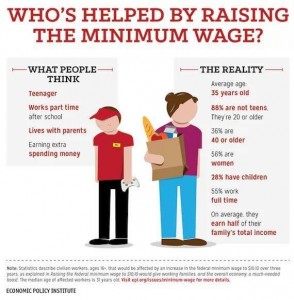This pretty much debunks the myths about minimum wage workers as being primarily teenagers who live at home with mom and dad.
As has been noted elsewhere, an increase in the minimum wage would help pull a lot of folks out of poverty, but most especially people of color.
People of color are far more likely to work minimum wage jobs, as they represent 42 percent of those earners even though they make up just 32 percent of the workforce.
That big number is in large part thanks to the overrepresentation of people of color in low-wage restaurant industry jobs. Over 500,000 of those lifted out of poverty by a raise in the minimum wage would be restaurant workers, 300,000 of whom would be workers of color.
I wanted to post this today, a day honoring Dr. Martin Luther King Jr., because fifty-one years ago Dr. King gave his famous “I Have a Dream” speech in Washington, D.C., and one of the ten demands specifically articulated by Dr. King and the rest of the march’s organizers was a “national minimum wage act that will give all Americans a decent standard of living. (Government surveys show that anything less than $2.00 an hour foils to do this.)”
Adjusted for inflation, the $2.00 an hour national minimum wage demanded by Dr. King and the organizers of the march in Washington, D.C. would be over $15.00 an hour.



Recent Comments